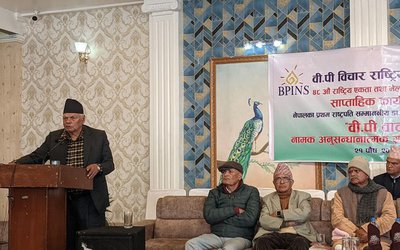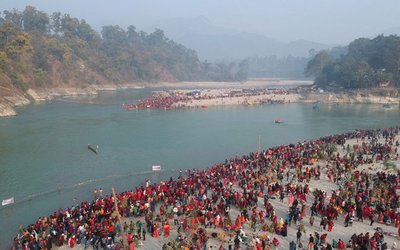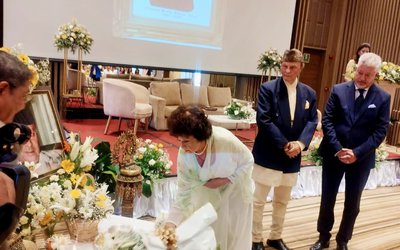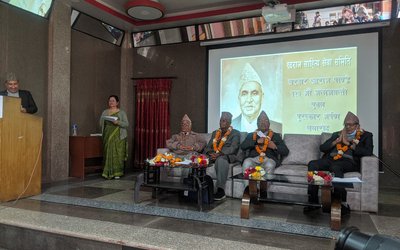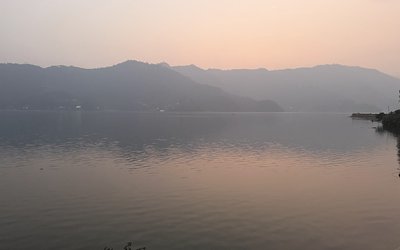A copy of Ranjit Rae’s (RR’s) ‘Kathmandu Dilemma’ aka ‘Resetting India-Nepal Ties’ reached my hands recently. I like to think of it as ‘Nepal Dilemma’ for this present capital, was known as ‘Nepal’ at the time of Prithvi Narayan Shah. Even during the earlier years of Rana rule, people from outside of Valley spoke of going to Nepal when they visited the capital. It was then habitual for many Nepalis to spend their evening years at Kashi. Our links with India go back many centuries considering that the Pandavs spent a year in King Virat’s kingdom, which presently lies within present day Nepal. Ours is a country is special as the saying which goes ‘Kashi, Kashmir Azeeb Nepal’.
It may be noted that the British had a difficult time in trying to conquer the Afghanis and the Nepalis, read Gurkhas. Whilst they did not succeed in Afghanistan, the British conflict with the Nepalis ended with the 1816 Treaty of Sugauli and the taking back by them the areas west of the Mahakali and east of the Teesta. Following departure of the British from India in 1947, Nepal’s relationship with the New Sahibs has had its ups and downs.
RR writes that it was Home Minister Vallav Bhai Patel of India who made Nepal agree to the establishment of 17 check posts on its northern border. Whilst noting in 2004 that TIA i.e. Kathmandu airport went by name of Gauchar previously, RR fails to consider that if Patel had lived longer Nepal would have been merged in India like the princely states or have a Bhutan like status. The present reality is that future hydropower developments of the Kosi, Gandaki and Mahakali Rivers have been handed over to India, without a time frame of development which is of great disadvantage to Nepal.
During Vajpayee’s premiership and when Jaswant Sinha was foreign minister the Indian fear was that the Maoists in Nepal might tie up with the Andra terrorists and the Sri Lankan LTTE. There is a strong belief in Nepal that Tamils were aiding the Maoists. It is common knowledge too that many Maoist leaders spent 8-10 years in NOIDA but that this fact was unknown to Indian authorities is very surprising! Except perhaps for Prachanda’s, the plea of non-availability of their photos to be able to arrest them is a very lame excuse! As has been noted, is it ‘India running with the hares and hunting with the hounds’?
At the time of PM Modi’s visit to Nepal many people here, especially Madeshis and Janajatis had their aspirations. The attempts by the Maoists during the first 1st Constituent Assembly was in favour of ethnic aspirations. The 2nd Constituent Assembly deducted the number of provinces, the composition of both the House of Representatives and the Upper House. The police action and shooting of demonstrating Madeshis during Sushil Koirala’s premiership led to increased tension in southern Nepal. Because of a leaked internal memo to an Indian Daily it was presumed that India was backing the Madeshis. India’s concern was that Nepal government’s ignoring Madeshis and Janjati’s concerns would result in ‘prolonged instability and turmoil in the country’. The give and take process of the Terai demand is that from the initial proposal of one or two states the final result was that the Terai area finally ended up within two major provinces and three hill districts. One wonders who the instigators were for the ‘Six months blockade’ of goods entering Nepal that took place at that time. One reflects that after the Constitution of Nepal was passed, the Govt. of India ‘noted’ and did not ‘welcome’ it.
The present reality is that India has got agreements on Koshi, Mahakali, Tanakpur, Gandaki plus the selection of Indian firms in West Seti and Arun III. The passage of MCC by parliament ensures that electricity will pass through the transmission lines erected by US support on to India. SPP developments are claimed to be in limbo at present. Though Nepal is in the process of selling electricity to Bangladesh, Nepal’s hands are tied as far as China is concerned. With the likelihood of ‘Fijikaran’ or ‘Simmikism’ being dropped or a non-starter, the possibility of Nepal’s relationship with India being changed to one similar to what India has with Bhutan cannot be ruled out. Major hydropower development in this country currently seems of being ‘locked, stocked and barrelled’ in India’s favour.
It is a fact that in days of yore, the Nepali army had been fighting with British Indian troops and subsequently the Sugauli Treaty of 1816 CD was signed with them. A problem has arisen with Nepal’s new map, published during Oli’s premiership. As per RR’s book this area has a 200 year history, had at first been captured by Gorkha troops in 1790 CE. The 335 sq. km. of Indian Territory, incorporated into Nepal was reverted back to the East India Company following the treaty of Sugauli of 1816 CE after a period of 25 years. Various papers quoted regarding the pros and cons of the case should be India, Nepal or at the British India Office Library at Aldwych in London. The many original papers all need to be scrutinised by experts as the Lipulekh problem has to be sorted out one way or the other. In this connection one way out of this impasse would be by India providing by way goodwill a road access to Nepal to Bangladesh and its ports through the ‘Chicken Neck’ section of India that lies in between.
The 1950 Treaty of Peace and Friendship.
PM Modi during his visit to Nepal in Aug. 2014 had stated options about the 1950 Treaty with India:
(1) To abrogate or
(2) Review and amend it as desired by Nepal.
At this juncture an eminent persons group (EPG) with five members each from India and Nepal was formed and over the course of two years they met alternately in India and Nepal. The report submitted over three years ago has not been looked at or considered. Would a totally new treaty be the best option?
Reason for conflict is that over the years there had been a number of incidents when India had not informed Nepal about its proposed military action (re Pakistan & future Bangladesh). Similarly Nepal too took similar actions during King Mahendra’s reign without informing India. It is therefore time to make amends and update the treaty as India has done with Bhutan.
The Tripartite Treaty: The Gurkha Connection.
The first Maoist demand for the closure of Gurkha recruiting by Britain in Nepal was in 1996. The Maoist led government tried to do so again in 2012. The statement of Pradeep Gyawali in mid 2020 that the Tripartite Agreement signed in 1947 between Nepal, India and UK should be scrapped, and replaced with two separate agreements by Nepal with UK and India makes sense. About 4.000 personnel were recruited annually by India. With the introduction of the ‘Agnipath’ scheme of mid June 2022 for non commissioned army personnel in India, the annual recruitment of about 3,500 Nepalis has been stalled. In the case of the British, the recruitment per annum is about 450 of both sexes is also fairly insignificant. The British also recruit for Gurkha Contingent for Singapore and Brunei. What should be a pre-requisite in this case is that all those selected should be given temporary citizenship whilst serving, with the option of permanence after five years.
As per Wikipedia classical military recruiting was started by the French in 1831 CE in Algeria. They have a reputation for being more egalitarian to people in their colonies. No questions were asked of anyone wanting to join with the option of citizenship after three years or immediately on being wounded. This certainly was a considerate and humane move. The French Foreign Legion was disbanded in 1962 at the end of the Algerian war. Currently, with wars going on all over the world it is likely that many individuals do join as mercenaries, labelled volunteers in foreign armies. Presently, there are such expatriate individuals fighting in Ukraine. In the case of Nepal some ex-soldiers also serve in the police force or as guards in Singapore or Afghanistan.
One third of Nepal’s population is categorised as working outside i.e. 6 million in India and 4 million in Gulf and Malaysia. RR mentions that the main reason for political instability is perhaps corruption, lack of good governance and inadequate reform programs. What RR fails to mention is the internal disturbances created by the NGOs with external support and INGOs with their hidden agendas. This situation is further increased by multiple countries that have been playing active roles over the years in the political field by interfering Nepali government functioning periodically! Reality is that since the time of Mohan Shumsher, Nepal has always turned to India at times of trouble but is never satisfied with the solution that India provides! Perhaps because it serves Indian interests more.
Nepal is graduating from LDC to a developing country by 2043 CE. Hydropower developments with India have concerned Koshi, Gandaki, and Mahakali rivers. Co-operation in hydropower development is related to utilisation for irrigation and electricity generation from flowing water or storage projects. The objective is flood control and to reap benefits of irrigation and power. RR contends these hydropower projects conceived are opposed by politicians. The reasons for this are plain – delays as in the past for starting and completion of projects. Compare this to even the non-starting and one does not have to look further. The reality of many such projects is that the land in Nepal is sub-merged whilst the agricultural benefits go to India! Thus the possibility of Tri-partite projects e.g. with Bangladesh are more likely to succeed. A power project in Laos for electricity in Thailand is quoted as a success story. Why not projects in Nepal for export of electricity to both China and India?
RR mentions too the 500 hundred Small Development Projects which India has implemented over 20 years in the hills and plains of Nepal. These are success stories creating immense goodwill. The volume of trade is hugely in favour of India as the export of agro-goods across Nepal’s border is said to be partly hindered due to state regulations of Bihar and UP. Farm products from India enter easily whilst similar perishable products from Nepal are held up causing much loss to Nepalis. It is only recently that Nepal manufactured cement and iron rods are being exported to India. As far as Indian firms in Nepal are concerned, Dabur is a success story. The lack of Indian interest for investment in Nepal is said to be due to the little protection of patents and trademarks. Visits by Indian tourists in Hindu and Buddhist religious circuits are rightly highlighted. Increased investment in medicinal plants and herbs would be fruitful. Another is the production of organically produced fruits and vegetables for export and internal combustion. The setting up of vocational training centres as at Biratnagar and the proposal for one at Hetauda are identified as beneficial for training personnel for future needs in various fields.
India was the first country to respond to the 2015 earthquake with its epicentre at Barpak in Nepal. Much relief was provided by India in its wake with the aid of planes and helicopters for the Nepali populace. This effort is stated as being the largest Humanitarian Assistance Disaster Relief (HADR) by India up to now. Relief efforts were co-ordinated with the Nepali army. Many Indian NGOs were involved too after they had received permission from the GOI to transfer funds for relief work. The close contact over the years of Nepali and Indian army helped immensely in HADR’s work in Nepal.
The mention of ‘Roti-Beti Rishta’ explicitly denotes that Nepal India relationship from the time of Lord Ram and King Asoka are intricately linked since centuries and though inter-border incidents occur from time to time, the relationship will continue albeit with periodic assessments. The situation of buharis and jwais regarding citizenship will have to be critically looked at from both sides and settled equitably. RR first visit to the Pashupatinath temple helped him to recognise the traditional links with India in that the priests at the temple at Kathmandu have always been from Karnataka. PM Modi visited the temple on the auspicious 1st Monday of Shrawan (4th Aug. 2014). Previous VIP visitors included PM Narsimha Rao and President Pranab Mukerjee. The movement of Indians pilgrims to Pashupatinath, Muktinath, Janakpur and Lumbini, compared to the movement of Nepalis to Varanasi, Gaya and Char Dham are quoted. The long standing traditions associated with Buddhism – visits of King Ashok and Charumati his daughter are mentioned. An essential undertaking, as it is lacking, is for Indian Buddhists to construct a monastery at Lumbini. That Guru Nanak visited Nepal some 500 years ago is another important event. The wife of Maharaja Ranjit Singh, as also those of many Muslim rulers found refuge in Nepal even when the British were in power in India. Many Kashmiris and Sikhs have played significant roles in the development of Nepal. The statement at the very beginning is one that makes a reader wonder:
“Everything that binds us -- religion, culture, traditions, language, ties of kinship -- also creates tension.”
However this relationship, though it has had its ups and downs, will hopefully continue with the necessary realisation for adjustments on both sides.
Following the great earthquake, it was the blockade of goods coming from India to Nepal from Sept. 2015 to Feb. 2016 that led to the then PM Oli to reach out to China. Though Chairman Mao had projected Tibet as a palm and Nepal as one of its fingers, the subsequent Panchasheel made Hindi Chini Bhai Bhai in 1954. B.P. Koirala’s subsequent visit to China had resulted in the official resolution of Nepal’s Northern border and Chairman Mao is said to have officially suggested that Mt. Everest should be renamed Friendship Summit. Post 1962 India is perhaps sore at Nepal as it had developed friendlier ties with China. Sikkim was merged with India in 1974-75. The Zone of Peace proposal by King Birendra was put forward at the time of his Coronation in Feb. 1975. It is stated that because of Jana Andolan I and anti-aircraft imports by Nepal that the blockade by India was instituted. The fall of the Panchayat regime is ascribed to this.
Was India upset as King Gyanendra did not consult them prior to his proposal of the membership of China to SAARC? Was this like the action of King Mahendra years before that led to India fearing Nepal’s closer proximity to China? With the proposal of PM Oli, transit facilities across Tibet and China had been agreed upon. Nepal joining the BRI has been taken amiss by both India and US. While the ratification of MCC has been done, the SPP agreement has perhaps still to be submitted to parliament. The Indo-Pacific Partnership has been trying to get Nepal into its fold. Investments in hydropower, airports between Indian and Chinese companies are being discussed. The fact that completion of Indian aided projects is invariably delayed whilst that taken up by the Chinese usually finish on schedule is mentioned. The dealing with the Chinese is opposed whilst the same dealing with India is condoned. The reality, to note is that massive amounts of pharmaceutical ingredients are imported by India to make medicines in India. Whilst in the past many Chinese products reached Calcutta via Nepal, there is now direct importation into India as trade must go on. In such an existing situation, why is India so Sinophobic? After all as the US relationship with China has its ups and downs and periodically varies with the ruling political power, so also it is in India. However one recalls that a massive transit railway contract given to a Chinese company was cancelled in the wake of the Ladakh confrontation.
Though the mass conversion of many Nepalis to Christianity is mentioned, the surreptitious way in which this was done and Nepal made into a secular state in spite of massive opposition from the populace, by the underhand means of some members of the then Constituent Assembly are intriguing.
The world now is no longer what it was in the 1950s because of the remarkable developments all over as a result of faster communication due to the progress in information technology. Conditions of living have changed much for the one billion Chinese whilst it is in the process of doing so for the one billion Indians too. The scenario of poverty exists in India, it is worse in Nepal. Many inequalities remain in both our countries and many of our citizens have to seek work in the Gulf or in the countries of S.E. Asia. The ones with modest resources go to countries of Europe or to the Americas. It is surprising that whilst India is advocating ‘Atmanirvar’ Bharat for itself and sending many exports to Nepal it is creating obstacles for Nepali agro products at its common border. Hopefully the Indian concept of Sabka Sath, Sabka Vikas, Sabka Viswas does not have a hidden agenda of ‘All peoples are equal but some people are more equal than others’. The world is changing rapidly and many skills are no longer required. Old methods such as recycling are out dated and ‘use & throw away’ in vogue. US leadership is being questioned; China and India are on the rise. Nepal is hankering for its own identity, is keen to shake off Indian dominance but at the same time wants to retain its relationship to India. The fact is that India does have substantial co-operation with China but looks askance at the efforts of Nepal. It is suggested that BIMSTEC & BBIN make renewed efforts to become extra active as SAARC is no longer functioning. Relationship of Nepal with India has to be much increased. RR states that India must no longer promise but must deliver as China does. Hydropower projects e.g. Pancheswar to help both countries is stressed upon. Border crossings should be regularised to ensure that it is not a security risk. One more quotation at the very end sums up what should be future action;
“There is no option but for the two countries to grow together in harmony with each other. Nature and geography have so ordained, and this will remain a fact of life in the foreseeable future.”
What does the future hold for the Nepali people now that a substantial number of Nepali youth have been elected to the House of Representatives? Will the Indo-Nepal relationship be affected in any way as there is a wind of change blowing in the country? Must it be reset? Or is it simply as the Nepalis say, ‘Back to Mangalman’?
The book states at the very beginning that it is written from an Indian perspective. It however gives a very wide and comprehensive account of Indo-Nepal relationship over the centuries and is a book which should be widely circulated both in India and Nepal. It is simply a ‘must read’ book. A Nepali translation titled perhaps ‘Nepal’s Dilemma’, as the book is all about Nepal’s relationship with India would be appreciated by many in Nepal. Considering that the book was conceived or planned in a short time, it is well penned and I congratulate RR for it as it adds to the political literature about Nepal.

Hemang Dixit
The author writes fiction under the name of Mani Dixit. Website: www.hdixit.org.np. Twitter: @manidixithd
- Top Heavy
- Sep 20, 2023
- Most Able?
- Sep 04, 2023
- Changing Times
- Aug 21, 2023
- Nepali Shenanigans
- Aug 03, 2023
- Budget Naataks
- Jun 29, 2023


